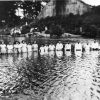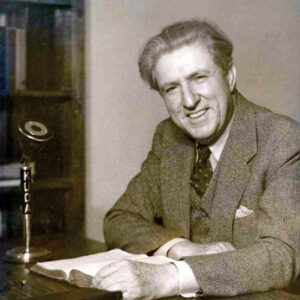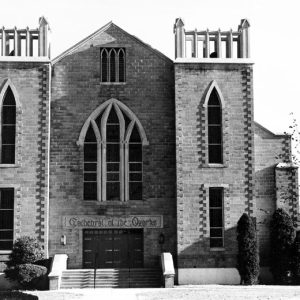calsfoundation@cals.org
John Brown University (JBU)
Founded in 1919 in Siloam Springs (Benton County), John Brown University (JBU) is a private comprehensive university known for its Christian identity, academic emphasis, and professionally oriented programs. The university began as a high school and junior college that emphasized vocational training for poor young people. It evolved into a four-year liberal arts university and later developed graduate programs in business and counseling. Throughout its history, the university has forged close ties with the churches and industries of northwest Arkansas and business leaders such as Sam Walton and John Tyson.
JBU was founded by John Elward Brown, a self-educated evangelist, publisher, and radio entrepreneur who grew up in rural poverty in late-nineteenth-century Iowa. In July 1919, Brown, at that time a prominent evangelist in Southern California with a family home in Siloam Springs, decided to establish a college that would offer practical vocational training in a Christian setting for poor, ambitious young people who could not afford a college education. One month later, Brown returned to Siloam Springs and converted his 300-acre farm into a college campus. Thus, in September 1919, Southwestern Collegiate Institute began its first semester as a non-denominational Christian vocational school with seventy students and a handful of teachers. A few years later, the college changed its name to John E. Brown College, and eventually to JBU, in order to capitalize on the founder’s fame as an evangelist.
In its first two decades, JBU functioned primarily as a school for the poor, combining religious and vocational instruction. The college initially sought to offer free education to all of its students. When this proved unfeasible, the college began charging nominal tuition and fees while relying on wealthy donors to cover the rest of the costs. Students attended classes half a day, spending the other half working in college industries such as a machine shop, a dress factory, a cannery, and a dairy barn. In keeping with the founder’s strict religious beliefs, students took mandatory courses in the Bible and attended daily chapel. In addition, a host of rules governed the daily lives of the students, who were not allowed to venture off campus without special permission. Brown summed up his educational philosophy in the slogan “Head, Heart, and Hand,” a phrase that has characterized the university from the 1920s to the present.
In 1924, Brown bought the Kihlberg Hotel in Sulphur Springs (Benton County), along with much of the downtown, and opened a school there called John Brown University, intended as a place to educate the children of Brown’s wealthier donors and as a complement to JBU in Siloam Springs; he had closed it by 1926, saying that he had consolidated it with the Siloam Springs school.
In the middle decades of the twentieth century, JBU evolved both educationally and religiously. As academic expectations increased, students spent less time working in the college industries. At the same time, however, new vocational programs were added in engineering, broadcasting, publishing, and home economics. In 1935, Brown purchased the rights to the radio station KUOA, which had formerly been the radio station of the University of Arkansas (UA) in Fayetteville (Washington County). The station became the voice of JBU, and it exists today as one of the oldest continuously operated radio stations in the United States.
The university remained firmly ensconced in conservative Protestant morality. In 1944, the founder and students campaigned vigorously in support of a “dry” law banning the sale of alcohol in Benton County—a prohibition that continued into the twenty-first century. In other ways, however, the university’s strict religious character moderated in the mid-twentieth century. JBU gradually moved away from the strict fundamentalism of such institutions as Bob Jones University and joined the more moderate wing of American evangelicalism. This transformation was symbolized when Billy Graham, the leading evangelist of the twentieth century, visited JBU in 1959.
After Brown’s death in 1957, leadership of the university shifted to the founder’s son, John Brown Jr. The university permanently added intercollegiate athletics in the late 1950s, and in 1962, it received accreditation from the North Central Association of Colleges and Universities.
Since the 1960s, JBU has grown steadily in size, diversity, and academic quality while seeking to maintain the traits that marked its founding. The student body, numbering only 325 in 1961, grew to 768 by 1969 before falling into the mid-500s in the 1970s. In 1979, a third Brown, John Brown III, assumed the presidency with an inauguration featuring an address by Governor Bill Clinton. Brown’s tenure was marked by resurgence in enrollment, culminating in a campaign to surpass the 1,000 mark by 1991, which resulted in 1,044 students on campus. In 1994, Lee Balzer assumed leadership of the university and presided over the establishment of graduate programs as well as overall growth in facilities and the student population. He was succeeded by Charles Pollard in 2004.
As the university expanded in the 1980s and 1990s, it also established ties with prominent business figures in northwest Arkansas. In the 1980s, Walmart Inc. founder Sam Walton became acquainted with JBU through his company’s chief operating officer, Donald Soderquist. In 1985, Walton established a scholarship fund to enable students from Central America to attend the university. With other international students from Africa, South America, and Asia, the university enjoys an international student population of nearly approximately fifteen percent—surprisingly high for a private university located in northwestern Arkansas.
Walton’s association with JBU led to a close relationship between the university and Soderquist. He served as chair of the Board of Trustees, and in 1997, he made a contribution that enabled the university to establish the Donald G. Soderquist Center for Business Leadership and Ethics. This center, which sought to promote the application of ethical principles to the business world, further cemented ties between the university and corporations in northwest Arkansas, such as Tyson Foods, as well as national and international firms.
By the end of the twentieth century, JBU enrolled approximately 2,000 students in traditional undergraduate programs, graduate programs, and an adult degree-completion program, which holds classes in Fort Smith (Sebastian County), Little Rock (Pulaski County), and Rogers (Benton County). While maintaining a Christian focus and identity, the university since 1994 has been ranked as one of the top Southern comprehensive universities in the U.S. News and World Report college rankings. The university formed its College of Business in 2012 and added a nursing program in 2014; two years later, it opened a new health education building. Enrollment was 2,126 in the fall of 2016 and climbed to 2,343 in 2020. In 2021, the university announced the shuttering of its communications department due to low enrollment. The total enrollment in fall 2023 was 2,253.
For additional information:
John Brown University. http://www.jbu.edu (accessed June 15, 2023).
Ostrander, Rick. Head, Heart, and Hand: John Brown University and Modern Evangelical Higher Education. Fayetteville: University of Arkansas Press, 2003.
Williams, Earl. “John Brown University: Its Founder and Founding, 1919–1957.” Ed.D. diss., University of Arkansas, 1966.
Rick Ostrander
John Brown University
 Arkansas' Independent Colleges and Universities
Arkansas' Independent Colleges and Universities Religion
Religion John Elward Brown
John Elward Brown  John Brown University Cathedral
John Brown University Cathedral 




I attended JBU from 1956 to 1960 and ran track on the first two intercollegiate teams in 1959 and 1960. We also introduced intercollegiate basketball in the 1958-59 season, under Coach Sam Starkey. (I was a cheerleader that first year.)